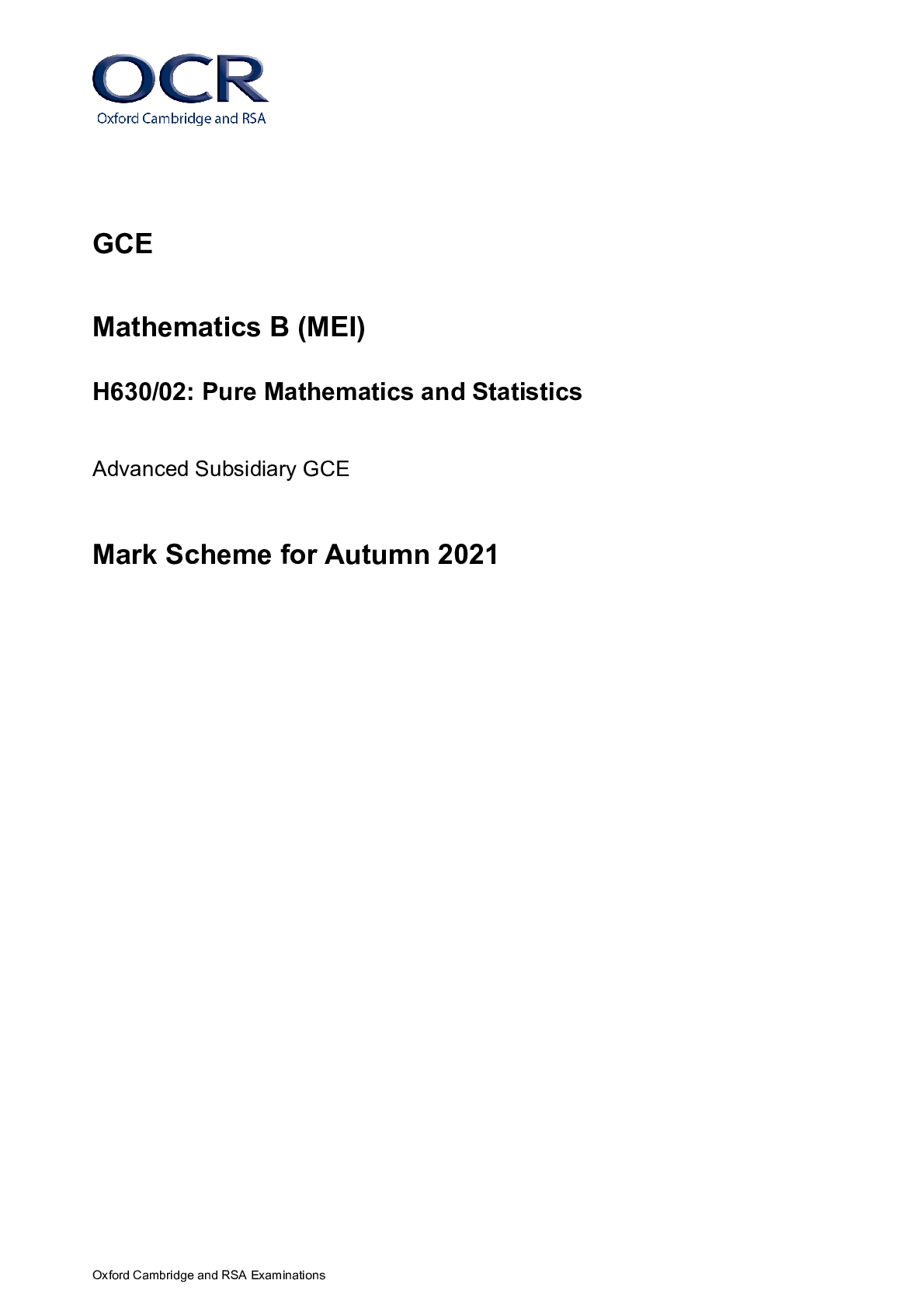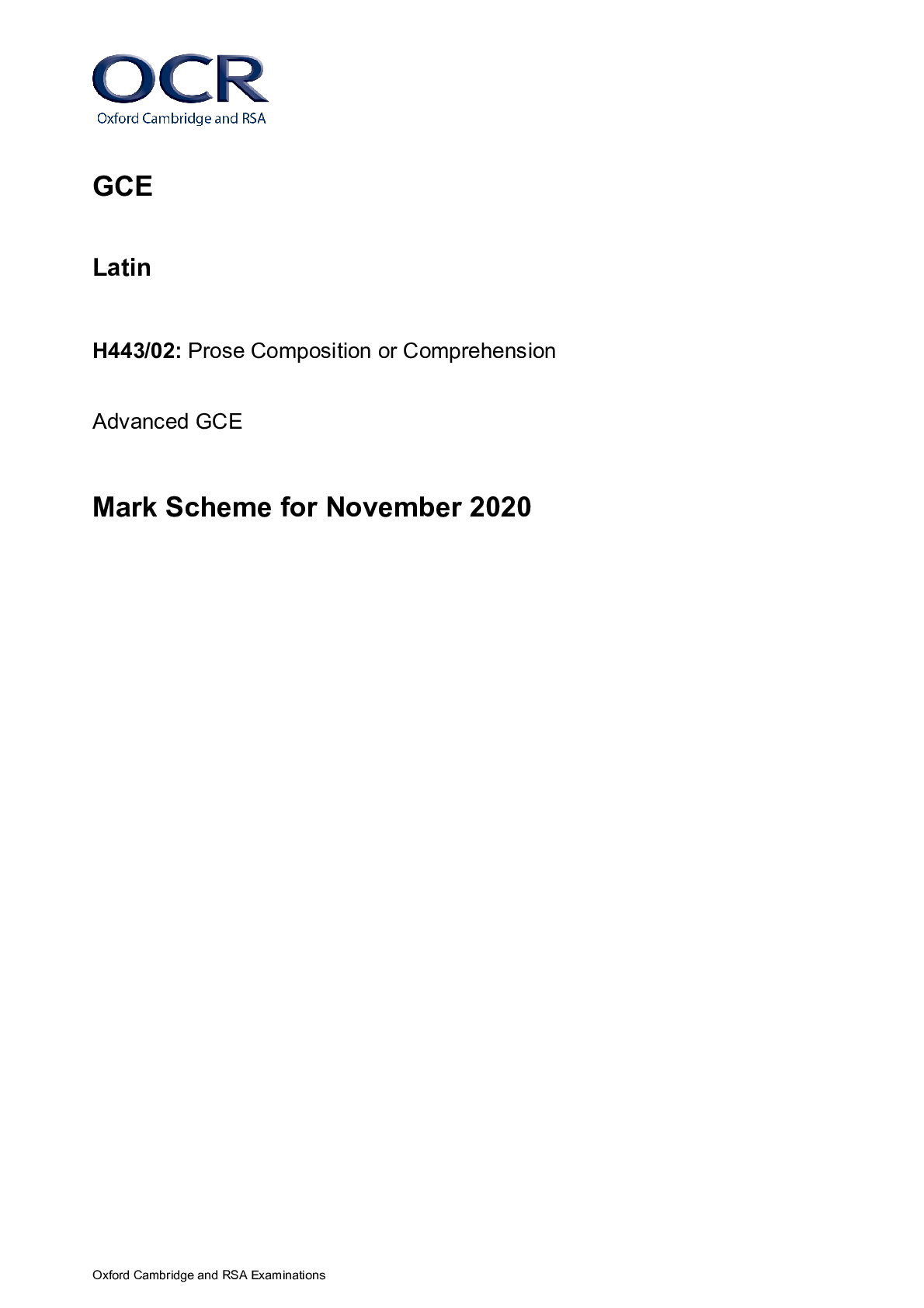Biology > GCSE MARK SCHEME > GCE Biology B H422/03: Practical skills in biology Advanced GCE Mark Scheme for Autumn 2021 (All)
GCE Biology B H422/03: Practical skills in biology Advanced GCE Mark Scheme for Autumn 2021
Document Content and Description Below
GCE Biology B H422/03: Practical skills in biology Advanced GCE Mark Scheme for Autumn 2021 Oxford Cambridge and RSA Examinations GCE Biology B H422/03: Practical skills in biology Advanced GCE ... Mark Scheme for Autumn 2021Oxford Cambridge and RSA Examinations OCR (Oxford Cambridge and RSA) is a leading UK awarding body, providing a wide range of qualifications to meet the needs of candidates of all ages and abilities. OCR qualifications include AS/A Levels, Diplomas, GCSEs, Cambridge Nationals, Cambridge Technicals, Functional Skills, Key Skills, Entry Level qualifications, NVQs and vocational qualifications in areas such as IT, business, languages, teaching/training, administration and secretarial skills. It is also responsible for developing new specifications to meet national requirements and the needs of students and teachers. OCR is a not-for-profit organisation; any surplus made is invested back into the establishment to help towards the development of qualifications and support, which keep pace with the changing needs of today’s society. This mark scheme is published as an aid to teachers and students, to indicate the requirements of the examination. It shows the basis on which marks were awarded by examiners. It does not indicate the details of the discussions which took place at an examiners’ meeting before marking commenced. All examiners are instructed that alternative correct answers and unexpected approaches in candidates’ scripts must be given marks that fairly reflect the relevant knowledge and skills demonstrated. Mark schemes should be read in conjunction with the published question papers and the report on the examination. © OCR 2021H422/03 Mark Scheme October 2021 Annotations Annotation Meaning DO NOT ALLOW Answers which are not worthy of credit IGNORE Statements which are irrelevant ALLOW Answers that can be accepted ( ) Words which are not essential to gain credit __ Underlined words must be present in answer to score a mark ECF Error carried forward AW Alternative wording ORA Or reverse argumentH422/03 Mark Scheme October 2021H422/03 Mark Scheme October 2021 Question Answer Mark AO element Guidance 1 (a) (i) age(ing) 1 AO2.3 1 (a) (ii) variable word list / 12 words how it could have been controlled same words read to each participant OR variable health (of participants) / (named) example of suitable disease / (named) example of suitable disorder how it could have been controlled medical check before tests were done / exclude subjects with disease or disorders / AW OR variable (duration of short) pause how it could have been controlled same time for (short) pause / AW 2 AO2.3 AO3.3 One mark for variable and one mark for how it is controlled Variable must be linked correctly to how it is controlled for two marks ALLOW one mark for a correct variable even if how it is controlled is incorrectH422/03 Mark Scheme October 2021 Question Answer Mark AO element Guidance 1 (a) (iii) bar chart with bars of equal width and appropriate key for ‘correct’ and ‘incorrectly’ recalled words axes appropriately labelled and scale for mean number of words and plot area covers 50% of available space bars plotted correctly for ‘correctly’ and ‘incorrectly recalled’ words at least three error bars plotted correctly 4 AO2.8 Error bar constructed as mean +/- 1SD 1 (b) (i) Any one from: family history genetic differences / mutation severe / traumatic / repeated, head / brain, injury stroke high / elevated, blood pressure high / elevated, blood cholesterol smoking low level of, intellectual activity / AW 1 AO1.1 IGNORE ageing (as given in the question)H422/03 Mark Scheme October 2021 1 (b) (ii) Relative risk Both calculated values should be given to the same number of decimal places: (risk factor G) = 1.687 / 1.69 / 1.7 (risk factor H) = 1.599 / 1.60 / 1.6 G (has higher relative risk than H) 3 AO2.4 AO3.1 If both risk factor answers are incorrect ALLOW one mark for: Correct incidence equation for either G or H e.g. for G = 85/6 OR for H = 94/7 ALLOW error carried forward for MP3 if calculations are incorrect 1 (c) Alzheimer’s brain: (has) smaller / decreased, volume (is) more/ AW, deeply folded (has) wider, gaps between folds (has) narrower, folds (has) larger, ventricles / voids / AW 2 max AO2.5 IGNORE references to brain activity All marking points must be comparative ALLOW ora throughout 1 (d) gingipain / protease, hydrolyses / AW, protein, in myelin sheath / myelin (in brain tissue) (which causes) damage / death, of neurones (in brain tissue) (could) lead to formation of, tau proteins (in neural cells) OR (could) lead to formation of, β-amyloid (proteins) / plaques (in extra cellular spaces) 2 max AO1.1 AO2.1H422/03 Mark Scheme October 2021 1 (e) Statement is valid: (statement is) valid, because brain tissue (of mice) treated with enzyme inhibitor, reduced the concentration / had low concentration, of bacterial DNA / AW (statement is) valid, because brain tissue (of mice) treated with enzyme inhibitor had similar concentration of bacterial DNA to brain tissue of non-exposed mice / AW Statement is invalid: (statement is) invalid, because investigation involved mice / not tested on humans (statement is) invalid, because small sample size of mice / AW (statement is) invalid, because not all AD symptoms are caused by, P. gingivalis / bacteria 4 max AO3.1 AO3.2 Maximum of 3 marks if there is no reference to the statement validity at least once within the answer.H422/03 Mark Scheme October 2021 Question Answer Mark AO element Guidance 2 (a) Description Haemoglobin Myoglobin Can bind with up to four oxygen molecules Has highest affinity for oxygen Located inside skeletal muscle 2 AO 1.1 3 correct = 2 marks 2 correct = 1 mark 1 correct = 0 mark 2 (b) (i) minimal disruption to lifestyle / AW fast results small volume of blood for sample 1 max AO3.2 IGNORE can be ‘carried out at home’ or ‘used by patient themselves’ or ‘easy to carry’ (as given in the question) 2 (b) (ii) monitor / AW, blood disorder / named blood disorder determine the severity of, blood disorder / named blood disorder monitor / AW, response to treatment monitor suitability / AW, to become a blood donor 1 max AO1.2 e.g. ‘monitor anaemia’H422/03 Mark Scheme October 2021 2 (b) (iii) low hydration levels increases concentration of solutes in plasma, leading to artificially high results / AW 1 AO3.2 2 (c) (i) sigmoid(al) 1 AO1.1 ALLOW ’s-shaped’ 2 (c) (ii) (alveolar capillaries) 96 (%) AND (venous blood) 61 (%) 1 AO 2.4 BOTH readings needed for one mark 2 (c) (iii) all points plotted correctly sigmoid shaped and smooth continuous curve drawn and trend line only drawn between data plots 2 AO 2.8 i.e. trend line does not extend beyond last data plot 2 (c) (iv) fetus must / only, obtain(s) oxygen from mother’s blood as it flows through placenta fetal haemoglobin has higher affinity for oxygen / AW, so the fetus can obtain oxygen even at (very) low partial pressures of oxygen 2 AO1.1 ALLOW ORA throughoutH422/03 Mark Scheme October 2021 Question Answer Mark AO element Guidance 3 (a)* Please refer to the marking instructions on page 4 of this mark scheme for guidance on how to mark this question. In summary: Read through the whole answer. (Be prepared to recognise and credit unexpected approaches where they show relevance.) Using a ‘best-fit’ approach based on the science content of the answer, first decide which of the level descriptors, Level 1, Level 2 or Level 3, best describes the overall quality of the answer. Then, award the higher or lower mark within the level, according to the Communication Statement (shown in italics): o award the higher mark where the Communication Statement has been met. o award the lower mark where aspects of the Communication Statement have been missed. • The science content determines the level. • The Communication Statement determines the mark within a level. Level 3 (5–6 marks) Detailed explanation of how to use the potometer to obtain valid results to estimate the rate of transpiration with clear reference to control variables and how they will be taken into account AND how a suitable number of different light intensities are determined AND how the raw data will be collected AND how the raw data can be processed to estimate the rate of transpiration. There is a well-developed line of reasoning which is clear and logically structured. The information presented is relevant and substantiated. Level 2 (3–4 marks) Simple explanation of how to use the potometer to obtain valid results to estimate the rate of transpiration with reference to control variables and how some will be taken into account AND how different light intensities are determined AND how the raw data will be collected OR how the raw data can be processed to estimate the rate of transpiration. 6 AO1.2 AO3.4 Indicative marking points e.g. Control variables • control variables e.g. species / number of leaves / leaf surface area / humidity / temperature / light source (wattage) / windspeed • detail of how control variables taken into account e.g. same species / same number of leaves / measure leaf surface area (so rate can be calculated per unit of SA) / measure humidity / temperature controlled room to standardise room temperature / same light bulb which acts as source / fan used at same speed Light intensity • place light source at a suitable range of distances from potometer • range of 5 distances stated for light source • use of light meter OR use of inverseH422/03 Mark Scheme October 2021 Mentions measuring movement of air-water meniscus but no detail of calculation or further processing. May only give details of different positions of light source with no further detail of suitable range and number of positions. There is a line of reasoning presented with some structure. The information presented is mostly relevant and supported by some evidence. Level 1 (1–2 marks) Limited explanation of how to use the potometer to obtain valid results to estimate the rate of transpiration with reference to control variables OR how different light intensities are determined OR how the raw data will be collected OR how the raw data can be processed to estimate the rate of transpiration. There is an attempt at a logical structure with a line of reasoning. The information is in the most part relevant. 0 marks No response or no response worthy of credit. square law to determine LI (from distance between light source and potometer) Dependent data • measure distance moved by air-water meniscus over set time period • collection of repeats Processing data • calculation of distance moved over set time period • conversion of distance moved to volume (using formula for cylinder) • calculation of rate of water uptake i.e. volume ÷ time • calculate of mean rate of water uptake • further processing e.g. calculation of SD or appropriate statistical analysis e.g. use of unpaired t -test (to asses significant difference between 2 mean rates of water uptake at different light intensities) 3 (b) FIRST CHECK THE ANSWER ON ANSWER LINE If answer = 10 (µm) 12mm ÷ 1200 OR 1.2cm ÷ 1200 2 AO2.4H422/03 Mark Scheme October 2021 3 (c) (i) Describe: (as the leaf water potential decreases) rate of water loss decreases Explain: (because decreasing leaf water potential) lowers diffusion gradient (of water vapour), so less evaporation 2 AO2.5 3 (c) (ii) correct tangent drawn, in contact with trend line at 0.7MPa correctly calculated rate of change 2 AO2.8 i.e. rate of change = change in y ÷ change in xH422/03 Mark Scheme October 2021 Question Answer Mark AO element Guidance 4 (a) Mark first answer acute disease (has a) fast / rapid / AW, onset (has) fast, recovery time 1 max AO1.1 ALLOW ORA for chronic 4 (b) (i) (the people chosen) reflect the distribution of, characteristics of the whole population / AW 1 AO2.4 4 (b) (ii) FIRST CHECK THE ANSWER ON ANSWER LINE If answer = 70% (357 358 ÷ 511 670) x 100 2 AO2.4 ALLOW for one mark if calculated correctly but not recorded to 2sf 69.8% OR 69% OR 69.84% 4 (b) (iii) (may have) died (may have) emigrated / not traceable (for follow up questionnaire) AW (may have) withdrawn consent / AW 1 max AO3.2H422/03 Mark Scheme October 2021 4 (b) (iv) a community setting more difficult to control variables than in laboratory / AW (individual exposure to pollutants was only estimated) so data collected was not accurate / AW people may have relocated so exposed to different levels of air pollutants / AW lifestyles may change due to length of study / thirty years is a long time for lifestyles to stay the same / AW people may not tell the truth on questionnaires / AW genetic predisposition to respiratory diseases will affect the data / AW other named / specified lifestyle factors, may be also raise risk (of respiratory disease) 3 max AO3.4 e.g. smokingH422/03 Mark Scheme October 2021 Question Answer Mark AO element Guidance 5 (a)* Please refer to the marking instructions on page 4 of this mark scheme for guidance on how to mark this question. In summary: Read through the whole answer. (Be prepared to recognise and credit unexpected approaches where they show relevance.) Using a ‘best-fit’ approach based on the science content of the answer, first decide which of the level descriptors, Level 1, Level 2 or Level 3, best describes the overall quality of the answer. Then, award the higher or lower mark within the level, according to the Communication Statement (shown in italics): o award the higher mark where the Communication Statement has been met. o award the lower mark where aspects of the Communication Statement have been missed. • The science content determines the level. • The Communication Statement determines the mark within a level. Level 3 (5–6 marks) Detailed discussion that includes wide range of benefits of improved aerobic fitness AND addresses most F.I.T.T. factors AND several other factors. There is a well-developed line of reasoning which is clear and logically structured. The information presented is relevant and substantiated. Level 2 (3–4 marks) Discussion that includes some benefits of improved aerobic fitness AND EITHER at some F.I.T.T. factors OR other factors. There is a line of reasoning presented with some structure. The information presented is mostly relevant and supported by some evidence. Level 1 (1–2 marks) Brief discussion to include at least one benefit of improved aerobic fitness AND EITHER at least one of the F.I.T.T. factor OR at least one other factor. 6 AO1.2 AO3.3 Indicative marking points e.g. Benefits of aerobic fitness: • increased stroke volume • increased VO2 max • decreased resting HR • increased capillary density in lungs and surrounding skeletal muscles • increased efficiency in lipid metabolism • increased glycogen stores in skeletal muscles • increase in number and size of mitochondria in muscle fibres • strengthening skeletal muscles • improving efficiency of circulatory system • reducing blood pressure • improving mental health e.g. reducing stress / lowering the incidence of depression • reducing risk of diabetes • reducing risk of osteoporosisH422/03 Mark Scheme October 2021 There is an attempt at a logical structure with a line of reasoning. The information is in the most part relevant. 0 marks No response or no response worthy of credit ‘FITT’ FACTORS to be taken into account • frequency of exercise • intensity of exercise • time (duration) of exercise • type of exercise Other factors to take into account • Pre-existing medical conditions • Age • Previous level of fitness 5 (b) accurate representation of the tissue in the micrograph drawn drawing made with clear continuous lines AND no shading AND label lines horizontal without arrow heads touching observable structures two observable structures of the tissue labelled correctly e.g. • muscle fibre • detail of sarcomere e.g. A band / I band / Z line • (myocyte) nucleus • capillary two of the labelled structures annotated e.g. • muscle fibre - multi nucleate / contains numerous myofibrils • A band / dark band - contains actin and myosin • I band / light band - contains only actin 4 AO2.3 ALLOW error carried forward for correct annotations if structures labelled incorrectlyH422/03 Mark Scheme October 2021 • Z line – marks length of a sarcomere / junction of actin filaments • nucleus - controls activity of myocyte / contains genetic material of the mycocyte • capillary – delivers nutrients to mycocytes / removes lactic acid from myocyteOCR (Oxford Cambridge and RSA Examinations) The Triangle Building Shaftesbury Road Cambridge CB2 8EA OCR Customer Contact Centre Education and Learning Telephone: 01223 553998 Facsimile: 01223 552627 Email: general.qualifications@ocr.org.uk [Show More]
Last updated: 2 years ago
Preview 1 out of 19 pages

Buy this document to get the full access instantly
Instant Download Access after purchase
Buy NowInstant download
We Accept:

Reviews( 0 )
$7.00
Can't find what you want? Try our AI powered Search
Document information
Connected school, study & course
About the document
Uploaded On
Oct 07, 2022
Number of pages
19
Written in
Additional information
This document has been written for:
Uploaded
Oct 07, 2022
Downloads
0
Views
117



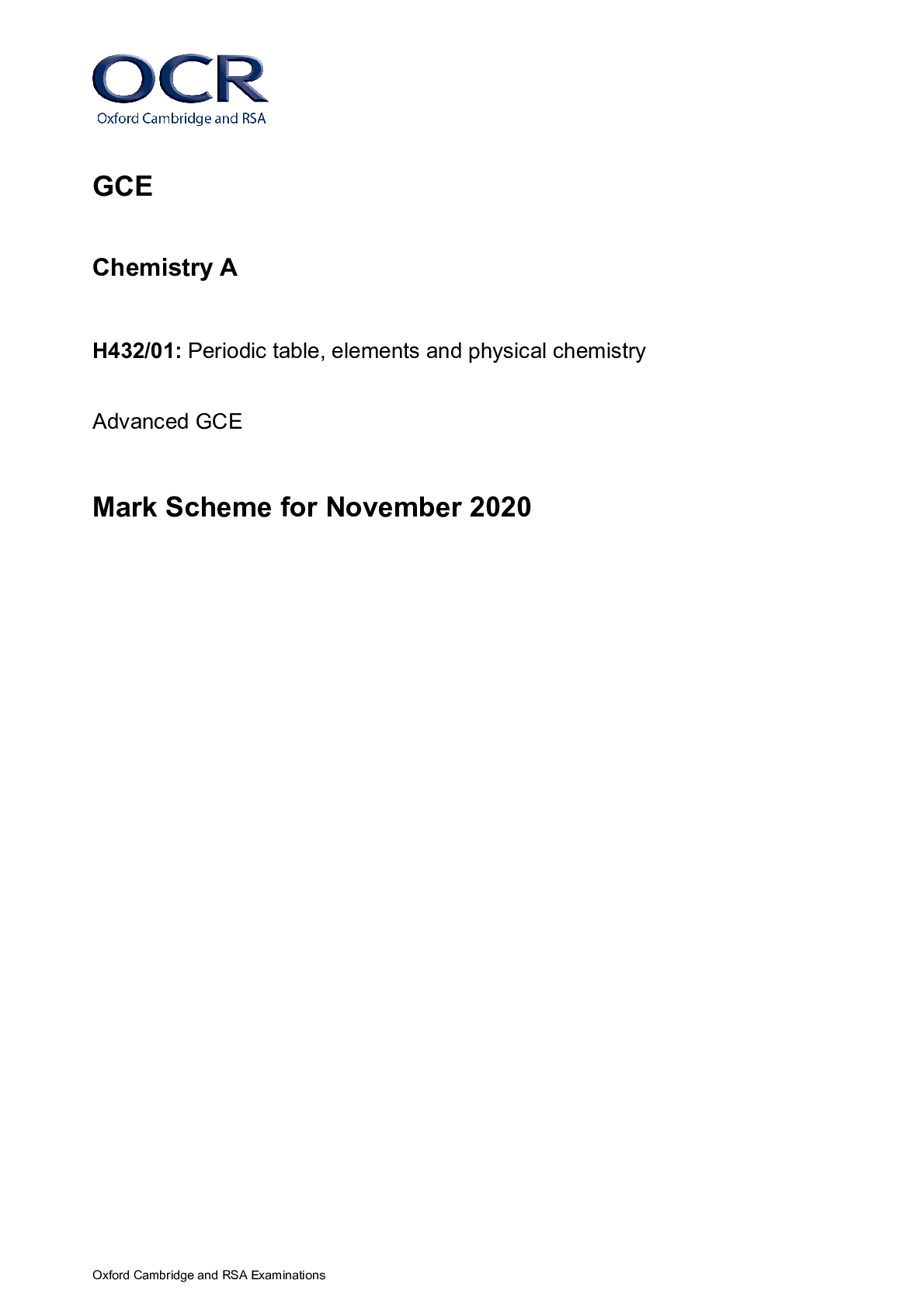
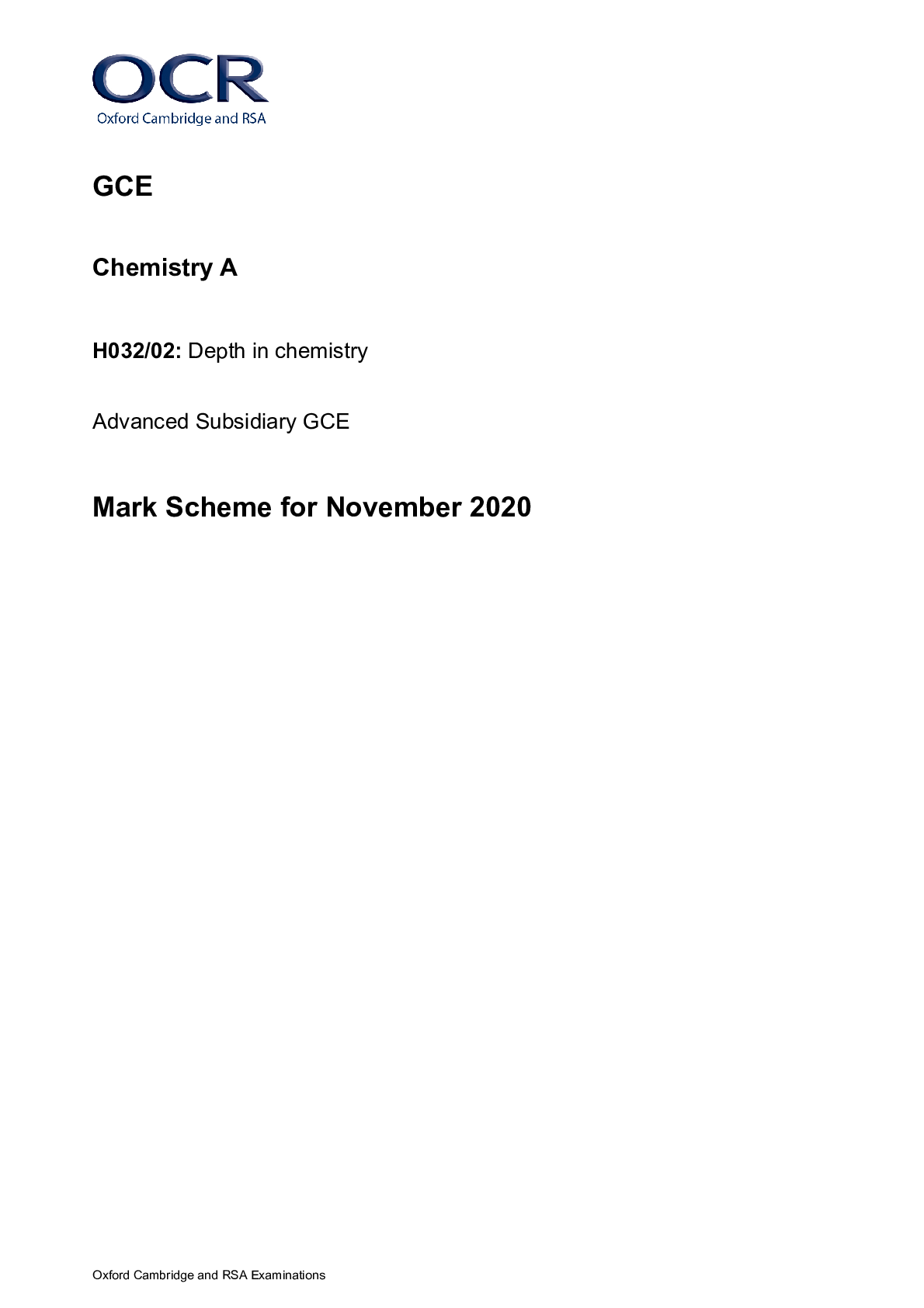



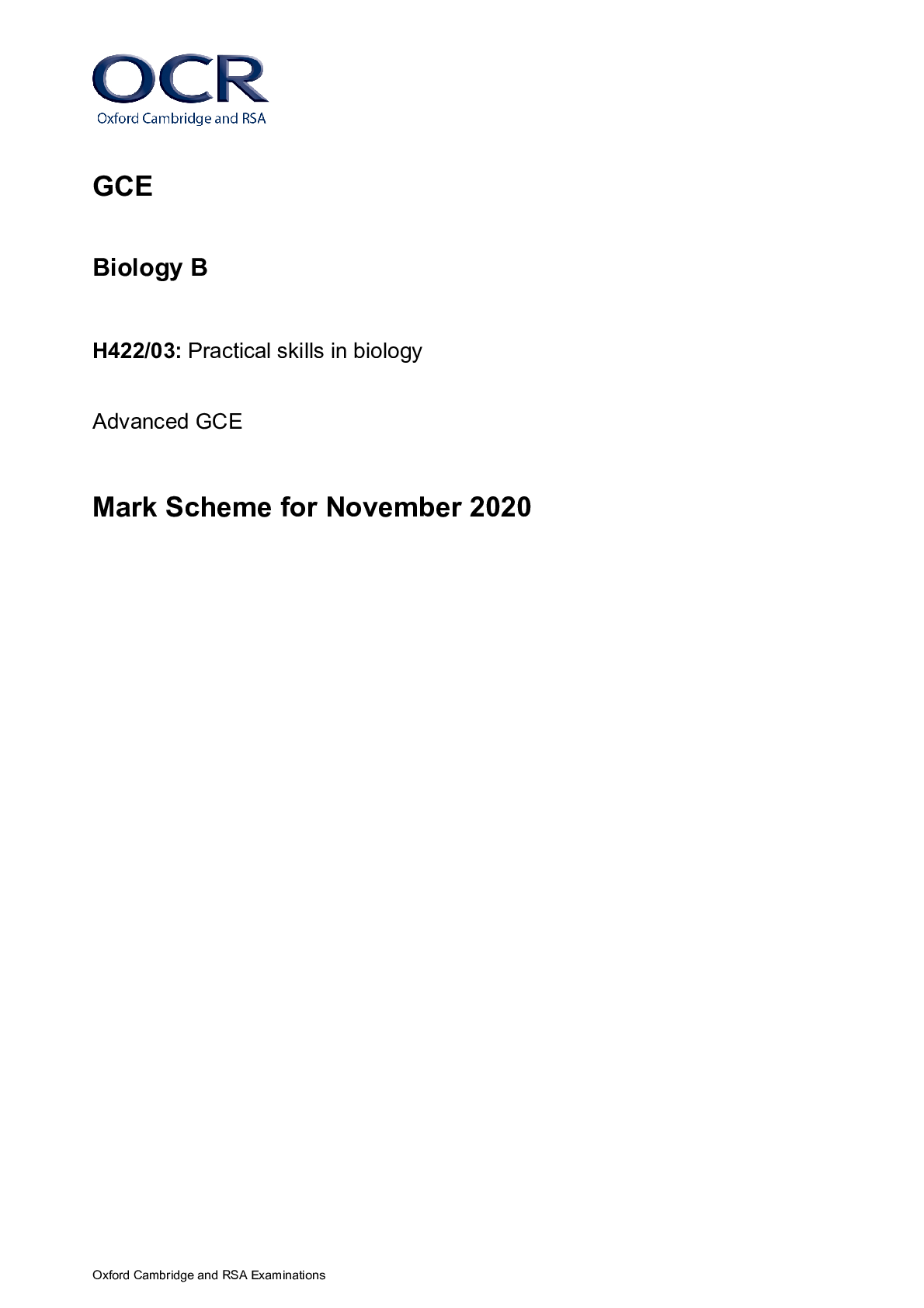
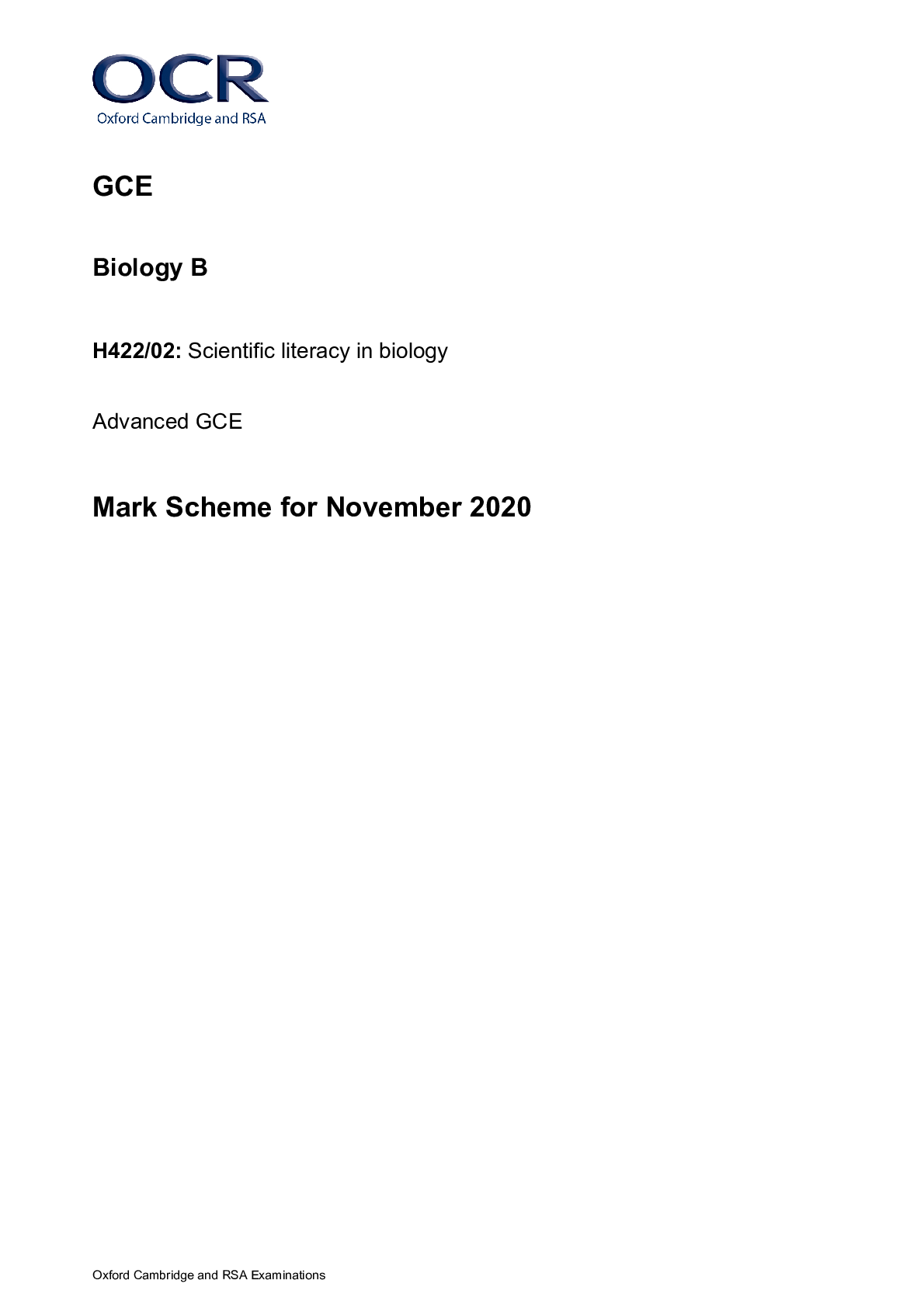
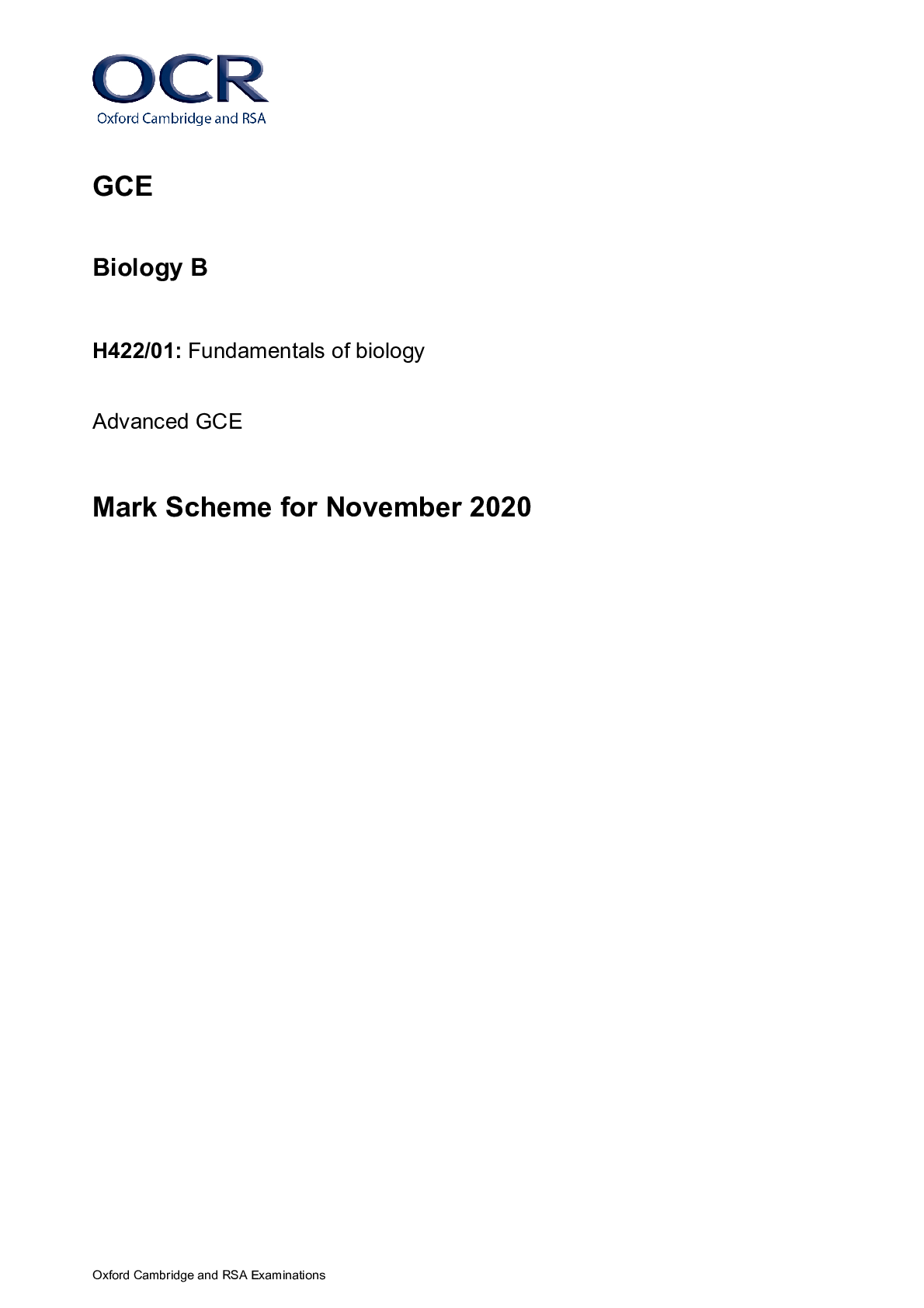


H630-02 Pure Mathematics and Statistics Advanced Subsidiary GCE Mark Scheme for Autumn 2021.png)



